The Queen City: George
Thornton
and Early Buffalo Chess
by John S. Hilbert
|
|
| Every story begins in the middle. The
history
of a town begs the history of those who came to build it. The
history
of a club begs the history of those who chose to found it. And the
history of chess in any metropolis of the United States, certainly
through
the course of the nineteenth century, is also the story of those who
helped
foster love of the game, both before and after city clubs were
officially
organized and tournaments begun. |
| Indeed, chess
in Buffalo, New York, the Queen City as it is known, took a dramatic
turn
for the better through the efforts of a man born some miles away, in
Watertown,
New York, on April 28, 1851. Watertown, just to the east of Lake
Ontario and due north of Syracuse, sits closer to that city than it does
to Buffalo. But when George Howard Thornton was ready for college,
he headed southwest, past Syracuse and on to the University of
Rochester,
where he graduated in 1872. Thornton had decided while at
university
to earn his living as a stenographer. As his obituary in the
January
31, 1920 issue of the Buffalo Express would state, “he
earned nearly
$2,000 during his senior year in this manner, and on his graduation
decided
to follow stenography as a vocation.” No wonder. Many
college
students today would be content to earn $2,000 during their senior year
in school, much less earn such money in 1872. At that time, a mere
seven years after the end of the Civil War and decades before Henry Ford
would offer his autoworkers the princely sum of five dollars a day for
their labor, such pay would have been difficult to reject. Even
more
so would it have been difficult to reject such a promising
career. |
| Following graduation from college in Rochester,
Thornton moved to Buffalo, New York, where he quickly became the junior
named partner in a stenography firm, Slocum Thornton, a concern that
Who’s
Who in New York, Third Edition (1907), informs us continued at least
for eight years, until 1880, when Thornton was twenty-nine.
Thornton
also immediately secured a position as assistant stenographer to the
supreme
court in the city, a decision that was to have significant consequences
for his later career. Thornton, it was said, “was
pre-eminently successful
in his chosen field, and as time went on and improved systems of
shorthand
were developed, he made it a practice to change his methods to maintain
the highest standards.” It was said of him that “his
notes are so
perfect any stenographer who uses the same system could read
them.”
And of course, of paramount interest to us, George H. Thornton also
loved
chess. |
| While working as a stenographer in Buffalo with
his own firm, the twenty-four year old Thornton played the following
game.
And he did so, as the Dubuque Chess Journal for June 1875 (at
pages
266-267) informs us, blindfolded. His opponent was a Rochester
player.
Black’s king is chased around the board’s center in merry
fashion, with
repeated pins along the e-file until, driven to distraction (and to the
edge of the board), he succumbs to a piece sacrifice and mate by rook
and
knight. |
|
Thornton,GH(bf) — Kimball
|
offhand
|
| C54/04 |
Giuoco Piano: Greco
|
|
|
Annotations by O. A. Brownson
Jr.
1.e4 e5 2.Nf3 Nc6 3.Bc4 Bc5 4.c3
Nf6 5.d4 exd4 6.cxd4 Bb4+ 7.Bd2 Nxe4 8.Bxb4 Nxb4 9.Bxf7+ Kxf7 10.Qb3+ d5
11.Qxb4 Re8 12.0-0 c6 13.Ne5+ Ke6
| ** |
So far Black has played
irreproachably,
but now plays unaccountably. |
14.Nc3 Nf6 15.Rae1 Qc7 16.Nxc6+
Kd7 17.Ne5+ Kd8 18.Qb3 Qb6 19.Qxb6+
| ** |
19.Nf7+ wins off hand, but White was
blindfolded,
and could not be expected to see everything. |
19...axb6 20.Nf7+ Kd7 21.Rxe8
Nxe8
22.Ne5+ Ke6 23.a3 Ra5 24.Re1 Kf6 25.b4
| ** |
The termination is admirably played by
White. |
25...Rxa3 26.Nxd5+ Kg5 27.f4+ Kh6
28.g4 b5 29.Nf7+ Kg6 30.Nh8+ Kh6
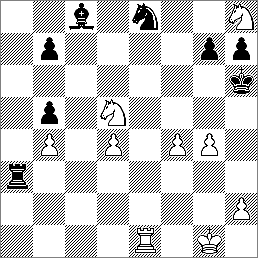 31.Re5 Bxg4 32.Rg5 Be6 33.Ne7
Re3
31.Re5 Bxg4 32.Rg5 Be6 33.Ne7
Re3
| ** |
Black seems to be in the dark here, 33...g6
was
safe; 33...Ra1+ draws easily and might have won. |
34.Nf5+ Bxf5 35.Nf7#
1-0.
Dubuque Chess Journal, 1875.06,
p266-267
|
| Thornton, of course, also played chess in his new
home city, Buffalo, and was successful there as well. The following
game,
also from the pages of the Dubuque Chess Journal, though slightly
later (December 1875, page 548) shows the young stenographer at work in
his own city. |
| C51/02 |
Evans Gambit: Anderssen
|
|
|
Annotations by O. A. Brownson
Jr.
1.e4 e5 2.Nf3 Nc6 3.Bc4 Bc5 4.b4
Bxb4 5.c3 Bc5 6.0-0 d6 7.d4 exd4 8.cxd4 Bb6 9.d5 Na5 10.Bb2 Nxc4
11.Qa4+
| ** |
11.Bxg7 wins rook and pawn for
bishop,
giving White an easy victory. |
11...Qd7
| ** |
As this shuts in the bishop, the
move
11...Bd7 seems preferable. |
12.Qxc4 Ne7
13.Nc3
| ** |
13.Bxg7 at this juncture would be
hazardous. Black would answer 13...Rg8 and if White plays the bishop at
the fourteenth move, 14...Rxg2+. If 15.Kxg2 checkmate follows in a few
moves, while if 14.Qc3, protecting the bishop at g7, Black plays
14...Qg4
winning the bishop. |
13...0-0 14.Na4
f5
| ** |
Not so good as 14...f6 holding
White’s
e-pawn in check, and neutralizing the contemplated attack [by way
of]
c3. |
15.e5 f4
| ** |
Apparently to make room for the
knight. |
16.e6
| ** |
First rate; effectively shutting up
bishop and rook, which are useless as though off the
board. |
16...Qe8 17.Nxb6
cxb6
| ** |
If 17...axb6, then
18.Qxc7. |
18.Qc3 Nf5 19.Nh4 Qe7 20.Nxf5
Rxf5
21.Rac1 f3
| ** |
Compelled to move
somewhere. |
22.g4 Qg5 23.Kh1
Rxd5
| ** |
23...Rf8 is better, but the game is
desperate. |
24.h3
| ** |
24.Qxc8+ Qd8 25.Qxb7 Rg5 26.Rc7 Qf8
27.Rf7 [and resignation might be his best
move—Author]. |
24...h5 25.Rg1
Qe5
| ** |
Demoralized. 25...Rc5 would now
equalize
the game. |
26.Qxc8+ (...),
1-0.
Dubuque Chess Journal, 1875.12,
p548
|
| The Buffalo player also played correspondence
chess
to keep himself active. Here is an encounter with a Niagara Falls
player in which Thornton misses his best chances. The game made
the
pages of the May 1881 issue of Brentano’s Chess
Monthly. |
|
Lamont,WL — Thornton,GH
|
corr.
|
| 188[0] |
USA; Buffalo, NY & Niagra Falls,
NY
|
|
Annotations by Alfred P.
Barnes
1.e4 e5 2.Nc3 Nc6 3.f4 exf4 4.d4 Qh4+ 5.Ke2 Qh5+ 6.Nf3
g5
| ** |
Staunton seems to be in favor of this line of play as he
remarks that Black will have a dangerous power of attack in few more
moves. |
7.Nd5 Kd8 8.Ke1
| ** |
We have not found any reply to White’s last move
that has
given us entire satisfaction, and hence arrive at the conclusion that
the
variation is not favorable to the second player; at this point however,
we think White should play 8.Kf2. |
8...Bg7 9.c3 Nge7
| ** |
We prefer the other knight to this square because, if
White
should neither exchange nor retreat, the knight can be dislodged by the
c-pawn. |
10.g3
| ** |
White makes an error here of which, however, Black does
not avail himself. The text move is an ingenious one, although
faulty.
The proper move seems to be 10.Be2. |
10...Nxd5 11.exd5 Re8+ 12.Kf2 fxg3+
| ** |
Very badly played; there was nothing for it but 12...g4,
which ought to result favorably to Black. We see no better move
than
13.dxc6 for White, and give a few variations: 12...g4: A)
13.Bxf4 Qxd5 14.Ng5 Qxh1 15.Nxf7+ Ke7 16.Qxg4 and Black can save himself
by 16...Kf8. B) 13.Ng5 Qxg5 14.dxc6 fxg3+ 15.hxg3 (15.Kxg3
Re3+ 16.Bxe3 Qxe3+ 17.Kg2 Qe4+ 18.Kg1 Bh6 and wins) 15...Qf5+.
C)
13.dxc6 fxg3+ 14.Kg2 (14.Kg1 is clearly ruinous) 14...gxf3+ 15.Qxf3
Qxf3+
16.Kxf3 dxc6 17.hxg3 Bf5 and Black retains the pawn. |
13.Kg2 g4
14.Ng5 h6 15.Bd3
| ** |
Well played; if the knight be taken the queen is
lost. |
15...f5 16.Bxf5 Rf8
| ** |
He might as well risked 16.hxg5. |
17.hxg3 Qe8 18.Re1 Ne7 19.Bxg4 Qg6
| ** |
If now 19...hxg5 20.Bxg5 Bf6 21.Bh5 etc. |
20.Qe2 Bf6 21.Ne4 Rh8 22.Nxf6 Qxf6 23.Rf1 Qg7 24.Bh5
Rf8
25.Qe5
| ** |
White terminates the game in good style. Of course
neither queen nor rook can be taken. |
25...Qh8 26.Rf7 Nxd5 27.Qxd5 1-0.
Brentano’s Chess
Monthly,
1881.05, p23
|
| But as for most of us, chess was not
Thornton’s
main occupation. In 1882 his work as assistant stenographer for
the
court paid off handsomely when he was named official stenographer of the
Supreme Court, Eighth Judicial District, a position he held for the next
thirty-eight years. And 1882 was not merely the date of his career
advancement: “In order to fulfill his duties more efficiently, he
studied
law and was admitted to the bar in 1882. In that year, he was
elected
president of the New York State Stenographers’
Association.” Yet
in that same year, 1882, Thornton won the New York State Championship,
as listed in Chess in New York State, December 1971 (then the
name
of the official publication for the New York State Chess
Association).
But his work was paramount. By the next year Thornton was editor
of the
Modern Stenographic Journal, a Buffalo publication.
And he was already the author of one book, Modern
Stenography.
He would also author another work, entitled Phonographic Copy
Books,
in 1884. |
| Thornton’s successful career as a
stenographer did
not prevent him from being an active member of many clubs, and indeed,
no doubt with his growing social position in the city, his membership in
various clubs became all the more important for the contacts they helped
him maintain. As was told much later, he became a member of the
“Buffalo,
University, Acacia, Yacht, Whist and Chess clubs.” Yet his
active
club life and career in stenography did not entirely prevent him from
playing
some very interesting chess, and against some very interesting
opponents. |
| In 1884 Thornton traveled to New York City, then
and now the heart of chess in the state as well as the country. Some of
his travels were reported by Charles Tutton in his fledgling chess
column
in the Buffalo Sunday Times. Tutton, in the course of
slightly
over two years (1884 through 1886), for example, would publish no fewer
than twenty-nine of Thornton’s chess games. The column itself
was
indicative of the growth of interest in chess in Buffalo. And the
extent of coverage offered Thornton was an even clearer indication of
his
dominance over the local chess scene. |
| Now thirty-four years old, and well established
in his field (he would shortly become president of the International
Stenographers’
Association), Thornton could indulge his interest in chess when on
trips,
at least to the extent of playing a series of offhand games at the
Manhattan
Chess Club. One of his games appeared in the Buffalo Sunday
Times
for July 27, 1884, and featured his play against a rather well-known
opponent.
The game was said to have been “played recently at the Manhattan
Chess
Club.” |
|
Thornton,GH — Steinitz,W
|
offhand
|
| C39/03 |
KGA: Kieseritzky (Paulsen)
|
|
| 1884.07 |
USA New York, NY (Manhattan
CC)
|
|
Annotations by Charles
Tutton
1.e4 e5 2.f4 exf4 3.Nf3 g5 4.h4
g4 5.Ne5 Bg7 6.d4 Nf6 7.Bc4 d5 8.exd5 0-0 9.Bxf4
| ** |
Not considered as good as
9.0-0. |
9...Nxd5 10.Bg3? Ne3 11.Qe2 Qxd4
12.c3 Qb6 13.Bb3 Be6 14.Nd2 Nc6 15.Nxc6 Bxb3 16.Ne7+ Kh8 17.axb3 Rfe8
18.Nc4
Nxc4 19.bxc4 Bf6 20.0-0-0 Rxe7 21.Qxg4 Bg7 22.Rhf1 Qb3 23.Rf2 Rf8 24.Rd3
Re6 25.Rxf7 Rxf7 26.Qxe6 Rf1+ 27.Be1 Qb6 28.Qxb6 axb6 29.Kd2 Kg8 30.Rd8+
Bf8
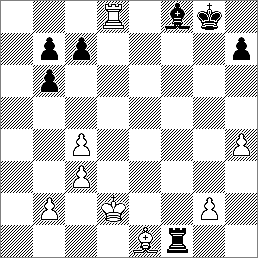 31.Rd7
31.Rd7
| ** |
But for this move White would have
stood a good show to win. |
31...Bd6 32.Ke2 Rg1 33.Kf2 Rh1
34.Ke2
Rg1 ½-½.
Buffalo Sunday Times,
1884.07.27
|
| Clearly Thornton could play a decent game of
chess.
In 1884 Wilhelm Steinitz, world chess champion, was only
forty-eight
years old, and not past his prime. Steinitz had left England the
year before to come to America, where he would eventually take United
States
citizenship. He had won Vienna 1882, placed second at the great
London
1883 event, and two years after the game above was played would crush
Zukertort
by a score of ten wins to five, with five games drawn. Other
successful
defenses of his title were still further ahead, against Gunsberg and
Chigorin,
before he would lose his title to Emanuel Lasker in 1894. |
| Thornton did not play only Steinitz at the
Manhattan
Chess Club on this trip. Tutton published another game of his on
August 10, 1884, against another New York player of some stature,
John S. Ryan. The brief notes are again by Tutton. His note
after Thornton’s thirty-seventh move reveals the world champion was
watching
the game as play unfolded. |
|
Thornton,GH — Ryan,JS
|
offhand
|
| 1884.0[7] |
USA New York, NY (Manhattan
CC)
|
|
Annotations by Charles
Tutton
1.e4 g6
| ** |
No author known to us looks
favorably
upon this opening, preferring the queen’s
fianchetto, 1...b6. |
2.d4 Bg7
| ** |
Mr. Potter prefers 2...d6, while
others
contend that 2...f5 is Black’s best
reply. |
3.Be3 c5 4.Nf3 Nc6 5.c3 cxd4
6.cxd4
Nf6 7.Bd3 Ng4 8.Nc3 Nb4 9.Bc4 0-0 10.h3 Nf6 11.Nh2 d6 12.f4 e6 13.a3 Nc6
14.Nf3 Nd7 15.Qd2 a6 16.0-0 b5 17.Ba2 b4 18.axb4 Nxb4 19.Bb3 Bb7 20.d5
exd5 21.Nxd5 Nxd5 22.Bxd5 Bxd5 23.exd5 Nf6 24.Rab1 Ne4 25.Qd3 Re8 26.b4
Qe7 27.Rfe1 Bc3 28.Bd2 Qa7+ 29.Kh2 Nxd2 30.Nxd2
| ** |
30.Rxe8+ would have saved the
pawn. |
30...Rxe1 31.Rxe1 Bxb4 32.Re2 a5
33.Ne4 f5 34.Ng5 Rc8 35.Ne6 Rc1 36.Nd4 Rc3
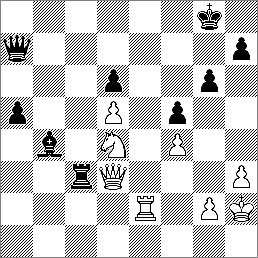 37.Qb5!
37.Qb5!
| ** |
Mr. Ryan thought that had he made
some other reply to the one actually made to this move he might have
escaped
the force of the attack, but Mr. Steinitz, who was watching the game,
pointed
out that White had a forced won game after this move, and that
Black’s
game could hardly be saved after his thirty-second move. |
37...Kg7 38.Ne6+ Kf6 39.Qe8 g5
40.fxg5#
1-0.
Buffalo Sunday Times,
1884.08.10
|
| John S. Ryan was not an easy man to beat.
Thirty-five at the time he faced Thornton, Ryan would be chosen eight
years
later, in the fall of 1892, as one of the eight strongest New York City
players to face a young Emanuel Lasker for one of a series of three game
exhibition matches arranged on Lasker’s first trip to the United
States.
The New York Tribune for October 18, 1892, for instance, would
refer
to Ryan as “the brilliant and popular amateur.” Although
Ryan could
not put a dent in Lasker’s chess armor when they battled, the very
fact
that he was selected at all as one of the eight players to face the
German
phenomenon is itself a testimony to his strength in the city. |
| At least one additional game has survived from
the
Buffalo player’s time at the Manhattan Chess Club. Here he
faces
a young man, then only twenty-one years of age, who would later face,
and
defeat, Jackson Whipps Showalter for the chess championship of the
United
States. The game, and notes, appeared in the pages of the
Buffalo
Sunday Times, this time on August 17, 1884. |
|
Lipschütz,S — Thornton,GH
|
offhand
|
| C38/03 |
KGA: Classical Knight (Hanstein)
|
|
| 1884.0[7] |
USA New York, NY (Manhattan
CC)
|
|
Annotations by Charles
Tutton
1.e4 e5 2.f4 exf4 3.Nf3 g5 4.Bc4
Bg7 5.d4 d6 6.0-0 h6 7.c3 Ne7
| ** |
The Handbuch gives 7...Qe7 as best
here. |
8.g3 g4
9.Bxf4
| ** |
9.Nh4 we think preferable here,
although
the Handbuch prefers the text move. |
9...gxf3 10.Qxf3 Be6 11.d5 Bh3
12.Rf2
Qd7 13.Be3
| ** |
We would suggest 13.Bxd6 as a
substitute
for the text move. |
13...Ng6 14.Bd4 Be5 15.Na3 a6
16.b4
Bg4 17.Qe3 b5 18.Bb3 Qe7 19.Raf1 Rh7 20.c4 bxc4 21.Nxc4 Bxd4 22.Qxd4 Nd7
23.Ba4 Kd8 24.Bc6 Rb8 25.Na5 Rb6 26.a3 Bh3 27.Rc1 Qe5 28.Qc4 Nb8 29.Ba4
f6 30.b5 axb5 31.Bxb5 h5 32.Qe2 Bg4 33.Qf1
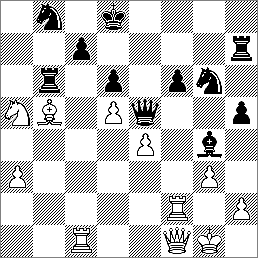 33.h4
33.h4
| ** |
Beautifully conceived and White
falls
into the trap. |
34.Nc4 Qd4 35.Nxb6 hxg3 36.hxg3
Bf3
| ** |
And now wishes he had not done
it. |
0-1.
Buffalo Sunday Times,
1884.08.17
|
| Later in the year Thornton traveled north of
Buffalo
into Canada, stopping in November in Toronto. While at a club
there,
he played an offhand game that Steinitz found commendable enough to
include
in his inaugural number, January 1885, of his International Chess
Magazine,
at pages 22-23. Steinitz’s notes are included below.
Interestingly
enough, Thornton’s opponent, C. W. Phillips, may well have been the
same
C. W. Phillips who near the end of the century would win the Continental
Correspondence Chess Tournament, organized by a group of Philadelphia
players,
including one of that city’s finest, Walter Penn
Shipley. |
|
Thornton,GH — Phillips,CW
|
offhand
|
| C39/02 |
KGA: Kieseritzky (Stockwhip)
|
|
| 1884.11.08 |
CAN Toronton, ON (Athenaeum
Club)
|
|
Annotations by Wilhelm
Steinitz
1.e4 e5 2.f4 exf4 3.Nf3 g5 4.h4
g4 5.Ne5 h5
| ** |
Paulsen’s
defense 5...Bg7 at this point is now generally acknowledged the
strongest.
It was first adopted by its author against Dubois in 1862, and its merit
has been tested since in various important match games as well as in
analytical
treatises. The answer 6.Nxg4 subjects White to a strong attack,
e.g.
5...Bg7 6.Nxg4 d5 7.exd5 Qe7+ 8.Kf2 best, for if he interposes bishop or
queen, Black captures the knight. 8...Bd4+ 9.Kf3 h5 10.Nf2 Bg4+ 11.Nxg4
hxg4+ 12.Kxg4 Nf6+ 13.Kh3 Rxh4+ 14.Kxh4 Ne4+ and wins. |
6.Bc4 Rh7 7.d4 d6 8.Nd3 f3 9.gxf3
Be7 10.Be3 Bxh4+ 11.Kd2 gxf3 12.Qxf3 Bg4 13.Qf1
| ** |
Here Steinitz gave as superior
for White 13.Qf4, offering as a likely continuation 13.Qf4 Nc6 14.Nc3
Nxd4
15.Bxd4 Bg5, but then continuing with 16.Bxh8, apparently in formulating
his analysis having placed Black’s rook on its original square,
rather
than the square it actually occupied, h7. His note continued
16.Bxf4+
17.Nxf4, claiming White would then have three pieces for the queen and
a fine game. The continuation no doubt is the product of the world
champion incorrectly setting up the board.—Author |
13...Bg5 14.Nf4
Qe7
| ** |
A weak move; the queen is badly
posted
here. He ought to have first developed 14...Nc6 and then brought
out the queen to d7. |
15.Nc3 Nf6
16.Re1
| ** |
Excellent for offensive and
defensive
purposes. |
16...c6
| ** |
He obviously could not play
16...Nxe4+,
for White after retaking would have withdrawn the bishop to g1, and if
then Black answered ...Bxf4+, White would simply play Qxf4, since
Black’s
queen remained pinned. |
17.Nfd5
| ** |
We give a diagram of this
interesting
position. |
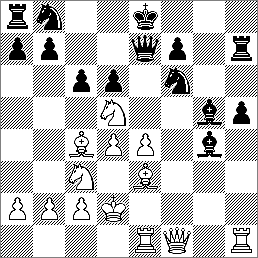
| ** |
White conducts the attack
vigorously. |
17...Bxe3+
| ** |
Ruinous. The proper play was
17...Nxd5, and if then 18.exd5, he could remove the king to d8 with a
fairly
defensible game and a pawn ahead. |
18.Rxe3 cxd5 19.exd5 Be6 20.dxe6
Kf8 21.exf7 Qd8 22.Rxh5
| ** |
Pretty and leading to an attractive
termination. He could also have won by 22.Qxf6 followed by Re8+,
Rg8+, and queening the f-pawn. |
22...Rxh5
| ** |
22...Nxh5 would have prolonged the
struggle, but only for a little while, for White after winning the queen
by Re8+, would ultimately play Qf5, attacking the rook and also
threatening
Qc8+. |
23.Re8+ Nxe8 24.fxe8Q+
1-0.
International Chess Magazine,
1885.01,
p22-23
|
| Thornton traveled the following year to Hamburg,
participating that July in the Fourth German Chess Federation Congress,
held in that city. There he played in the fourth preliminary
section
in hopes of qualifying for the final of the hauptturnier, the winner of
which would be recognized as having achieved the title of master.
His hopes, however, were not to be satisfied. And his play, no
doubt,
was highly disappointing, both to him and his friends. Thornton
finished
last in his section, managing only a third round win against the seventh
place finisher in his preliminary group. Here is his loss to his
section’s winner, the player who finished second in the finals of
that
year’s competition. The brief comments are my own translation
from
Der Vierte Kongress des Deutschen Schachbundes, Hamburg, 1885,
published
in Leipzig the following year. |
|
Bauer,W — Thornton,GH
|
(1)
|
| C51/01 |
Evans Gambit: Declined
|
|
| 1885.07.13 |
GER Hamburg (Hauptturnier, Section
4)
|
|
Annotations by Curt von
Bardeleben
(Translated by John Hilbert)
1.e4 e5 2.Nf3 Nc6 3.Bc4 Bc5 4.b4
Bb6 5.a4 a6 6.0-0
| ** |
Preferable is first
6.c3. |
6...d6 7.c3 Be6
| ** |
Far stronger was 7...Bg4.
Black’s
play lacks energy. |
8.Na3 Nf6 9.Qe2 0-0 10.d3 Nd7?
11.Bg5
Ne7? 12.Bxe6 fxe6 13.Qa2 Kf7 14.Be3 h6 15.a5 Ba7 16.Bxa7 Rxa7 17.Nh4 g5
18.Nf5 Nxf5 19.exf5 d5
20.d4 c6
| ** |
Wrong would be 20...e4 because of
21.fxe6+ Kxe6 22.Rae1 Nf6 23.f3. |
21.fxe6+ Kxe6 22.Rae1 Kd6
23.dxe5+
Nxe5 24.Qe2 Qf6 25.Qe3 Raa8 26.Qc5+ Kd7 27.Rd1 Qd6 28.Qb6 Qc7 29.Qe3 Rf6
30.c4 Ke6 31.Qc5 Qd6 32.Qb6 Rb8 33.Rfe1 Rf5 34.Nc2 Rf4 35.cxd5+ cxd5
36.Rxd5
| ** |
A pretty offer of the
rook. |
36...Qxb6 37.Rdxe5+ Kf6 38.axb6
Rc4 39.Ne3 1-0.
Der Vierte Kongress des Deutschen
Schachbundes,
Leipzig
1886, p222
|
| Returning to Buffalo he continued to expand his
contacts and responsibilities. “He reported the proceedings
of many
notable cases and gatherings. In 1889, he was official
stenographer
of the assembly and the following year was elected to the same position
in the state senate.” |
| By 1891 Thornton, as reported many years later in
the Buffalo Courier Express for January 16, 1938, had also become
involved in chess organization in Buffalo. “Prior to 1891
Buffalo
chess enthusiasts played the game in small informal groups. In the
fall of that year 80 players, under the leadership of Harry Richmond and
George Thornton, formed the local chess center which a year later became
the Buffalo Chess Club. The first clubrooms were located in the
Hermitage
Building at Court and Franklin Streets.” The next year
Thornton was
official stenographer for the New York State Constitutional Convention.
And other Herculean efforts filled his time: “Among his
monumental
works was the reporting of the proceedings of the Fassett Committee of
the legislature which filled 4,600 printed pages. For several
years
he also reported the meetings of the Chautauqua assemblies, under
contract
to provide at least twenty-six newspaper columns of matter
daily.” |
| And yet chess could still draw him from his
labors,
though not as readily, nor as consistently. The midsummer meeting
of the New York State Chess Association in 1894 was held in Buffalo,
under
the auspices of the very club Thornton had helped create.
Showalter
won a small, double round robin event over Pillsbury, Albin, and George
Farnsworth, the latter Buffalo’s own representative. Walter
Penn
Shipley, the well-known Philadelphia player, finished first in that
meeting’s
first class tournament, but no mention of Thornton was made. No
doubt
his professional obligations prevented his participation. |
| During the fall of 1895, and in all likelihood
into
the early weeks of 1896, Thornton conducted a correspondence game
against
Lieutenant F. L. Palmer, then of the 21st Infantry, United States Army,
located in Plattsburg, New York. The Albany Evening Journal
for February 8, 1896, from which the game and notes are taken, announced
the game as taking place between Palmer and Thornton, “the
well-known
Buffalo player.” However well known to readers Thornton might
have
been, he found himself up against stiff competition when he faced the
Lieutenant. |
|
Palmer,FL — Thornton,GH
|
corr.
|
| 1895-96 |
USA; Buffalo, NY & Plattsburg,
NY
|
|
Annotations by W. H. K.
Pollock
1.e4 e5 2.Nf3 Nc6 3.Bc4 Bc5 4.b4
Bxb4 5.c3 Ba5 6.d4 exd4 7.0-0 Nf6 8.Ba3 d6 9.e5
| ** |
A comparison of the opening of this
game with that in the famous recent encounters between Chigorin and
Steinitz
will go far to help the student how to discover the very best moves in
this branch of the Evans Gambit. The games referred to diverge as
follows: 6.0-0 d6 7.d4 exd4 8.cxd4 Nf6 9.e5 dxe5 10.Ba3 (we believe
10.Qb3
to be stronger) 10...Be6 11.Bb5 Qd5 12.Qa4, where Black has a choice of
three moves, 12...0-0, 12...Nd7, and 12...Bd7, of which the latter is
probably
the best. |
9...d5
| ** |
9...dxe5 would have given White a
terrible attack by 10.Qb3. |
10.Bb5 Ne4
11.cxd4
| ** |
Much stronger seems 11.Qa4 Bxc3
(11...Bb6
12.Bxc6+ bxc6 13.Qxc6+ Bd7 14.Qxd5 Nxc3 15.Nxc3 dxc3 16.Ng5 Be6 17.Qc6+
Bd7 18.Qf3 Be6 19.Rad1 and White wins) 12.Bxc6+ bxc6 13.Nxc3 Nxc3
14.Qxc6+
Bd7 15.Qc5 Nb5 16.Bb4 and if 16...a5 17.a4 axb4 18.axb5 with a
strong
attack. |
11...Bb6
| ** |
The bishop should generally be left
at a5 as long as safe, as it prevents the development of
White’s
b1-knight. We agree with Lieut. Palmer that here 11...Bd7 is much
better. |
12.Bxc6+ bxc6
13.Qc2
| ** |
This evinces care and is well
played. |
13...Bb7 14.Nbd2
Nxd2
| ** |
Mr. Palmer says “14...Ng5 was
much
better. If then 14...Ng5 15.Nxg5 Qxg5 16.Nf3 Qg6 and then castles with
a pawn ahead. Or if 14...Ng5 15.Rac1 Ne6 16.Nb3 and Black still has a
good
game. After 14...Nxd2 it would seem as if White must
win.” |
15.Qxd2 h6
| ** |
Fearing 16.Qg5, if 15...Qd7.
But as White breaks in another way, it proves but lost time. 15...h5
might
be suggested but there is really no good move. |
16.Rac1 Qd7 17.e6 fxe6 18.Ne5 Qd8
19.Rxc6 Qf6
| ** |
White presses his attack
skillfully;
if 19...Bxc6, 20.Qc2 wins instantly. |
20.Qc2 Kd8 21.Qa4
Kc8
| ** |
White announces mate in 14
moves.
The longest variation is as follows: 21...Kc8 22.Rxc7+ Bxc7 23.Qd7+ Kb8
24.Rb1! Qxe5 25.dxe5 Rd8 26.Qc6 Bb6 27.Bd6+ Rxd6 28.Qxd6+ Kc8 29.Rc1+
Bc6
30.Qxc6+ Kd8 31.Qxa8+ Kd7 32.Qb7+ Ke8 33.Rc8+ Bd8 34.Qc7 and mates next
move. |
1-0.
Albany Evening Journal,
1896.02.08
|
Appearances in the chess press became rarer for
the Buffalo stenographer as his professional 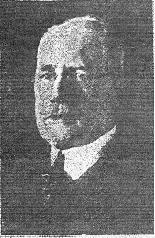 obligations
became more pronounced. Five years later, early in 1901, however,
there is record of Thornton participating as team captain for his city
against rival Rochester in an eight board team match played by
telegraph,
thus obviating the need for either team to travel the sixty-some miles
between cities through Western New York’s Snow Belt in
January. The
Chicago Tribune on February 10, 1901 published the short draw played
at board one between team captains Luce and Thornton, concluding the
game
represented “a species of Vienna draws. Lasker or Pillsbury
would
now begin to try to find a win. There’s lots of fight
left.”
Why Thornton offered a draw at this point is unclear, though the match
did finally concluded in a draw, 4-4. The game is given here, for
the record. Why the columnist for The Chicago Tribune
decided
to include it, if only a “Vienna draw,” is left to the
conjecture of the
readers. obligations
became more pronounced. Five years later, early in 1901, however,
there is record of Thornton participating as team captain for his city
against rival Rochester in an eight board team match played by
telegraph,
thus obviating the need for either team to travel the sixty-some miles
between cities through Western New York’s Snow Belt in
January. The
Chicago Tribune on February 10, 1901 published the short draw played
at board one between team captains Luce and Thornton, concluding the
game
represented “a species of Vienna draws. Lasker or Pillsbury
would
now begin to try to find a win. There’s lots of fight
left.”
Why Thornton offered a draw at this point is unclear, though the match
did finally concluded in a draw, 4-4. The game is given here, for
the record. Why the columnist for The Chicago Tribune
decided
to include it, if only a “Vienna draw,” is left to the
conjecture of the
readers. |
|
Luce,ND — Thornton,GH
|
Bd 1
|
| D35/01 |
Queen’s Gambit Declined
|
|
| 1901.01.05 |
USA; Rochester, NY & Chicago, IL
(telegraph)
|
|
1.d4 d5 2.c4 e6 3.Nc3 Nf6 4.e3
Nc6
5.a3 Be7 6.Nf3 0-0 7.Bd3 dxc4 8.Bxc4 a6 9.h4 Nd5 10.Ne4 f5 11.Nc5 b5
12.Ba2
Bxc5 13.dxc5 h6 14.Nd4 Nxd4 15.Qxd4 Qf6 16.Bd2 Qxd4 17.exd4 Bd7 18.0-0-0
c6 ½-½.
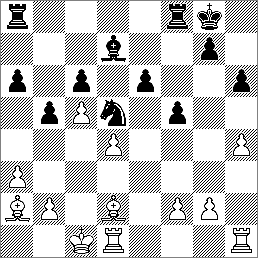
The Chicago Tribune,
1901.02.10
|
| A fifty year old Thornton also played in the 1901
midsummer meeting of the same association, once again held in
Buffalo.
Buffalo that summer was once more a natural choice, as the cool Lake
Erie
breezes and the presence of the Pan American Exposition of 1901 gave
both
players and their spouses added incentive to travel by train to the
western
reaches of New York. Thornton did not disappoint this time,
winning
the first class tournament with a score of 7½-1½.
Indeed,
the Buffalo Morning Express for August 13, 1901, wrote with
obvious
hometown pride that Thornton was probably “the strongest player
above the
Bronx,” and one who could “always be distinguished by the
characteristic
right hand twirl of a luxuriant mustache.” |
| Two Thornton games from the nine round, 1901
first
class tournament held in Buffalo have survived, one of which is given
below.
The Buffalo Express for August 14, 1901, from which the score is
taken, mentioned as well that “Thornton was forced to surrender the
exchange,
but obtained for it a strong combination of pawns well up on the
kingside
which he forced into a beautiful win, in spite of all his opponent could
do. The game merits consideration by chessplayers.” |
| C50/03 |
Italian: Four Knights (Pianissimo)
|
|
| 1901 |
USA Buffalo, NY (First
Class)
|
|
1.e4 e5 2.Nf3 Nc6 3.Bc4 Nf6 4.d3
Bc5 5.Nc3 0-0 6.Bg5 d6 7.Nd5 B g4 8.c3 Na5 9.Nxf6+ gxf6 10.Bh6 Re8
11.Bb5 c6 12.Ba4 b5 13.Bc2 Bb6 14.h3 Bd7 15.g4 Kh8 16.Qe2 Rg8 17.Nh4 f5
18.Nxf5 Bxf5 19.exf5 Qh4 20.Bd2 f6 21.b4 Nb7 22.Qf3 h5 23.Ke2 d5 24.Qg3
Qxg3 25.fxg3 Nd6 26.Kf3 Rae8 27.Rae1 Rg7 28.Re2 Bc7
 29.gxh5 Nxf5 30.g4 e4+ 31.dxe4
Ng3
32.Rhe1 Nxe2 33.Rxe2 Rge7 34.Bd3 dxe4+ 35.Rxe4 Be5 36.Re2 Rd8 37.Bf5
Rde8
38.h4 Bd6 39.Rxe7 Bxe7 40.g5 Rd8 41.Bf4 Rd5 42.Be4 Rd1 43.g6 f5 44.Be5+
Kg8 45.Bxf5 Rf1+ 46.Kg4 Rg1+ 47.Kh3 Bd8 48.h6 Rh1+ 49.Kg2 Rxh4 50.Be6+
Kf8 51.g7+ 1-0.
29.gxh5 Nxf5 30.g4 e4+ 31.dxe4
Ng3
32.Rhe1 Nxe2 33.Rxe2 Rge7 34.Bd3 dxe4+ 35.Rxe4 Be5 36.Re2 Rd8 37.Bf5
Rde8
38.h4 Bd6 39.Rxe7 Bxe7 40.g5 Rd8 41.Bf4 Rd5 42.Be4 Rd1 43.g6 f5 44.Be5+
Kg8 45.Bxf5 Rf1+ 46.Kg4 Rg1+ 47.Kh3 Bd8 48.h6 Rh1+ 49.Kg2 Rxh4 50.Be6+
Kf8 51.g7+ 1-0.
Buffalo Express,
1901.08.14
|
| But time stands still for no one. Though every
story
in a sense does begin in the middle, as the opening of this article
suggests,
for each of us, individually, the end is very clear cut. Thornton
continued his work as official stenographer to the Buffalo courts until
late in 1919, when, while working in Judge Brown’s courtroom in the
city,
he was stricken by complications associated with heart disease.
After
an illness of eleven weeks during which he did not leave his bed, he
succumbed
to heart failure at his home early on the morning of January 30,
1920.
He was buried a few days later in Forest Lawn Cemetery in Buffalo, New
York, last resting place of the Thirteenth President of the United
States,
Millard Fillmore. From his obituary we also learn that Thornton
was
survived by his wife and three grown daughters. A personal tragedy
in his life clearly was the death of his son, William L. Thornton, a
physician,
several years before his own passing. No one wants to bury a
child. |
| Buffalo had lost one of its distinguished
citizens,
and its chess community had lost one of its founding fathers.
Though
George Howard Thornton hardly played chess internationally, or even
nationally,
he remained throughout his life a valued member of the Buffalo chess
community,
one who helped western New York chess flourish. A solid club
player,
as we have seen, he could at times give a fight to the best of
players.
In a sense every city has its George Thornton, and for their
contributions
to chess on the local level, they deserve better than to be totally
forgotten.
And with Thornton’s passing, the Queen City had indeed, for a time,
lost
its King. |
|
© John S. Hilbert 1998
|
|
The author wishes to thank Nick Pope and Andy
Ansel
for their help with sources for this article.
|






 obligations
became more pronounced. Five years later, early in 1901, however,
there is record of Thornton participating as team captain for his city
against rival Rochester in an eight board team match played by
telegraph,
thus obviating the need for either team to travel the sixty-some miles
between cities through Western New York’s Snow Belt in
January. The
Chicago Tribune on February 10, 1901 published the short draw played
at board one between team captains Luce and Thornton, concluding the
game
represented “a species of Vienna draws. Lasker or Pillsbury
would
now begin to try to find a win. There’s lots of fight
left.”
Why Thornton offered a draw at this point is unclear, though the match
did finally concluded in a draw, 4-4. The game is given here, for
the record. Why the columnist for The Chicago Tribune
decided
to include it, if only a “Vienna draw,” is left to the
conjecture of the
readers.
obligations
became more pronounced. Five years later, early in 1901, however,
there is record of Thornton participating as team captain for his city
against rival Rochester in an eight board team match played by
telegraph,
thus obviating the need for either team to travel the sixty-some miles
between cities through Western New York’s Snow Belt in
January. The
Chicago Tribune on February 10, 1901 published the short draw played
at board one between team captains Luce and Thornton, concluding the
game
represented “a species of Vienna draws. Lasker or Pillsbury
would
now begin to try to find a win. There’s lots of fight
left.”
Why Thornton offered a draw at this point is unclear, though the match
did finally concluded in a draw, 4-4. The game is given here, for
the record. Why the columnist for The Chicago Tribune
decided
to include it, if only a “Vienna draw,” is left to the
conjecture of the
readers.
